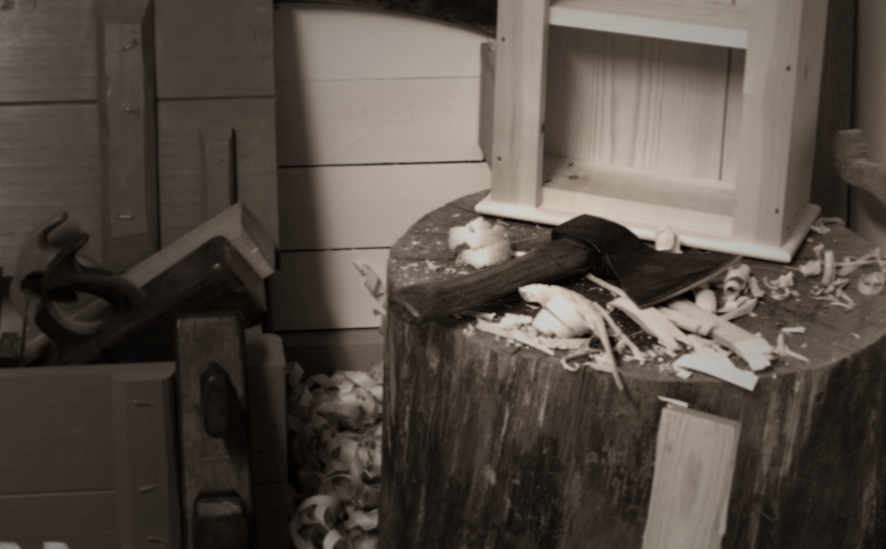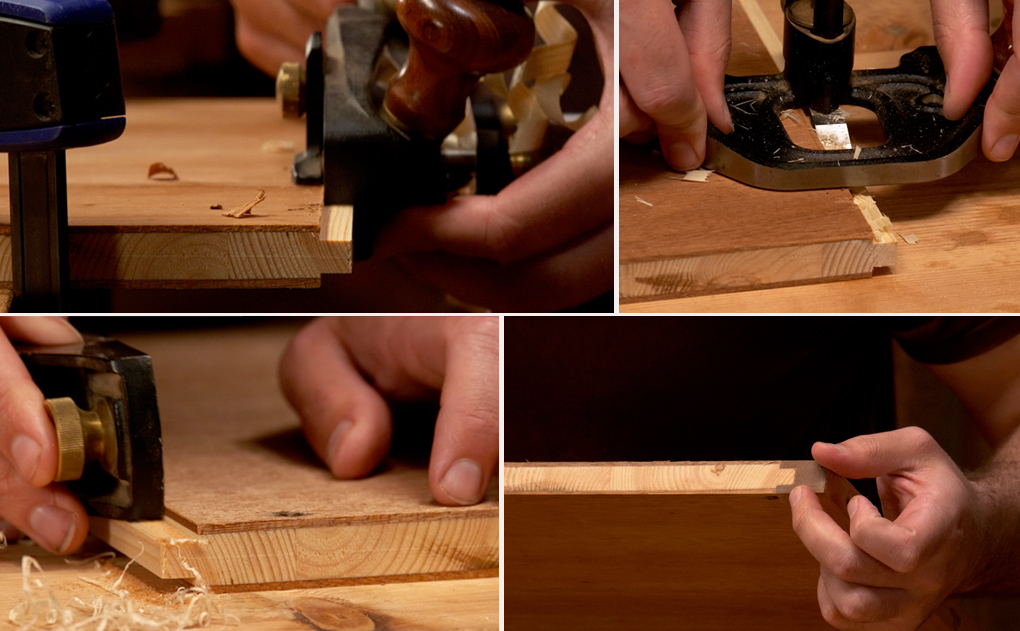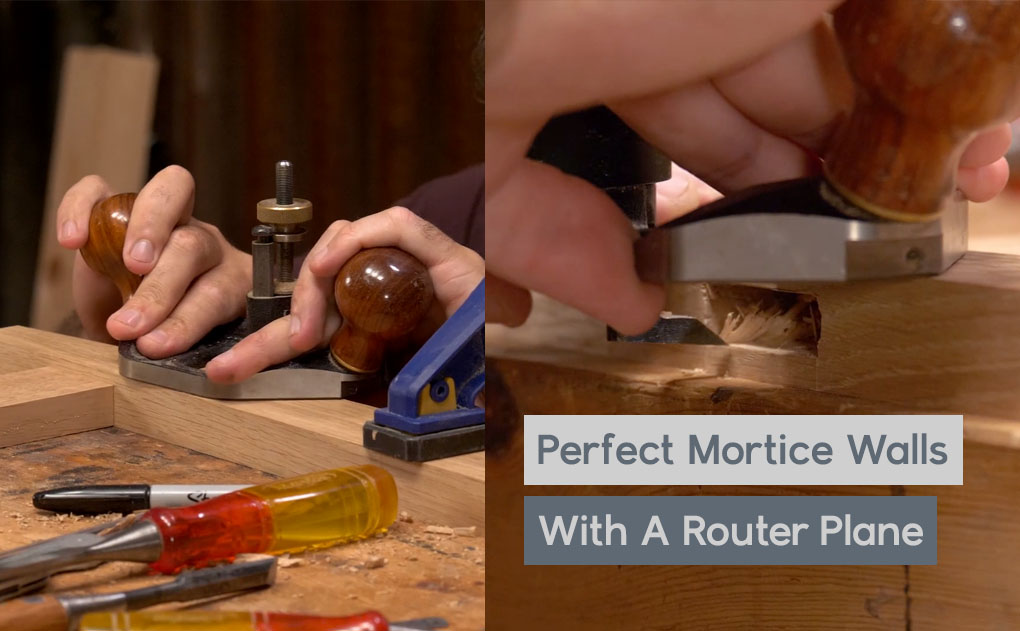Firstly we’d both like to say a big thank you to everyone for their response to our recent announcement. We’ve been reading through all of your comments and emails and have been somewhat overwhelmed by the level of support. This means a huge amount to us and will certainly help us along our way.
Today I wanted to write a little about my axe. This is one of my favourte tools and yet clearly isn’t that essential because you really don’t see that many of us using them. People often find it surprising that I use an axe, mainly because of the context; I use it in all of my furniture making rather than the usual woodland crafts or for cleaving firewood. 
I’m hoping to show a bit more about my use of an axe through some future videos but for now here are some of my main thoughts:
If everyone used an axe in furniture making then hand tools would definitely be considered more dangerous!
How many times have you clipped your thumb with your hammer?!
The axe which I use most is heavy and it’s a side axe.
Side axes are expensive and for most of us won’t really be worth it. Instead opt for a light weight hatchet. It gets used mainly for edge work and for this a hatchet will be just as suitable whilst being better balanced and so easier to use in the less experienced hand. Fatigue is the enemy with a tool like this so a more managable weight will be better.
Axes are a very fast and efficient tool once mastered.
There’s no quicker way to remove a lot of waste but it does take quite a bit of skill to gain the benefits. Using an axe is not only about taking precise blows but more importantly about understanding how the wood works. Once you can read your wood in an instant you’ll know exactly how to go about removing the waste in just moments. But with anything that’s fast it only takes one small mistake and you’ve ruined your work so you need to read your timber carefully – once you’ve gone past your line you can’t put material back!
I feel the videos will be a good way to really get across the use of the axe along with some important notes on safety but in the meantime if you fancy giving it ago, just remember that with this tool you’ll only hit your thumb once!

![Which Saws Are Best For Ripping Thick Stuff? [Video]](https://www.theenglishwoodworker.com/wp-content/uploads/2022/12/what-hand-saw-is-best-for-thick-rip-cuts.jpg)

![Quick Homemade Clamps – Small & Large [with video]](https://www.theenglishwoodworker.com/wp-content/uploads/2022/08/how-to-make-your-own-woodworking-clamps.jpg)

Hi Richard,
I wish I’d had the benefit of your blog a couple of weeks ago.
I used my axe to chop some kindling for the fire and ‘took my eye off the ball’ for a second. You guessed – I hit my thumb.
Fortunately, my thumbnail got in the way and stopped it going too deep, but it’s certainly made me more aware of the damage it could do.
It also highlighted the importance of having a First Aid kit in the workshop – axe wounds do tend to be deep and they just keep on bleeding! Anyone want any red kindling?
Keep up the good work.
Regards
Ian
Oooch! Bugger me, I bet that throbbed! I hope it heals up quick and doesn’t put you out too much.
Hello Richard,
You are spot on with the benefits of the side axe, a really underrated tool, as you observe ,”the” way to remove lots of waste in a hurry, together with my adze, I find it a must have tool!
I suppose the H&S man would have a fit to see us using one though!
Chris,
France.
The adze, that’s another good one. I must admit though I very rarely use one these days for some reason.
This is a helpful read, as I’ve been tentatively considering an axe for a while now. Do you have any experience with any modern brands such as Gransfors Bruks? Also, what do you think of small adzes for doing this kind of work? Thanks for the read!
Hi Simon, there’s a few of the Gransfors Bruks axes which have been on my tools to buy list for quite some time now. I believe these modern ones are as good as an axe gets.
I used to use an adze a lot when I was working with riven wood, and I used it mostly for face work. Once you get the hang of them they are a fantastic tool, although I tend to favour the axe in general for furniture making because they’re more suited for edge work and more of an all rounder.
Hi richard. Just thinking aloud, is it possible to get a kind of chain-mail safety glove for the hand holding the workpiece? I can’t remember seeing one anywhere. Regards barry
Some carvers use chain-mail gloves (Kevlar is also available I think) for carving with the workpiece hand-held. Might be worth trying a few woodcarvers’ suppliers.
Try butchers suppliers – you’ll find a lot of butchers use them (especially when they are training – if you watch a butcher honing knives on a steel you’ll understand why).
Great tool for any woodworker. Actually I don’t own one yet but have been meaning to get one for a while now. I use the same principle in splitting wood along the grain with a wide chisel when given the opportunity rather than sawing.
I think Paul sellers would agree with you too!
P.S. great blog by the way – recently discovered you by way of your youtube channel and realised how good the content was, both on your youtube channel and your website, so hand to subscribe to both! Keep up the great work!
I absolutely love using an axe. I own 2 a brades 2 1/2 pound kent pattern and a Finnish Roselli (only about 1 1/4 pound). Both are fantastic for serious woodworking purposes, not only axing out spoons, bowls, ladles, shovels etc but also to “rip” waste off of the edge of a board prior to scrub/jack planing to precise width, making arrises, even splitting oak to make draw pegs. The must have machinery wood-engineering mentality would regard an axe as a crude backward tool. But with practise it will work to surprisingly accurate tolerance, down to 1mm or less…
An solid, stable axe block (chopping block) is absolutely essential for safe and accurate working. The axe must be razor sharp as well. I say b####r the H&S jobsworths, what they wont get to see they cant pontificate about….! The sudgestion re chain mail gloves, I’d say its a waste of time and likely to induce a false sence of security. As long as you are keeping the workpiece-holding (non axe) hand ABOVE the axe edge at all times its not a problem. One reason for having a solid stable block to chop onto is that if the axe glances, it will come to rest in the block, not your femorial atery…Personally a router, table saw or planer/thicknesser never fails to induce fear and panic in me, but then its what you get accustomed to I suppose!
Thanks Jonathan, very good points especially the chopping block. The work surface is always as important as the tool and working with the axe is no exception.
Hi Richard,
I have watched all your videos and I learn something new every time. Just finished my version of the tool chest and I’ve started making several copies of the wall cupboard.
I have my dad’s axe and it’s sharp as the devil’s tongue. He kept it in with all his tools that he used for making Windsor chairs. I’d use it, but I’m left handed and he was right handed. I need to make another handle and turn it around before it will be any good to me. Meanwhile —
I’ve been using my drawknife and a mallet to split away the waste. Works wonders and I’ve only messed up one piece so far. Still learning to read the wood and I’m not cutting as close to the line as I could. I will be waiting to see your videos on the subject.
Congratulations on the new facilities and good luck to you both!
Wishing you the best from the States,
John
After seeing your use of the axe, I’ve been using one increasingly over the last few months. I have a block, similar to yours, on which I use it. I usually use a piece of wood to hold the piece I am chopping and that makes it both safe and aids accuracy in that you can line up the piece of wood where you want the cut to be and use it like a sort of fence (hope that’s clear). All good stuff 🙂
All makes perfect sense, and it sounds like a very good idea. I’m going to pop out and give it a try.
I’ve been working on the hand axe thing since watching the box video. I have a hewing axe (RH) that I made a handle for, curved away so I don’t skin my knuckles. Then I made a short handled axe for what purpose I don’t rightly know. I haven’t found a piece of log yet to use the the chopping block but I’m working on that.
Once I get a block to chop on, I’ll give it a go. I plan on being careful. Very careful.
Mike
http://i127.photobucket.com/albums/p124/mmurray_02/IMG_2138.jpg
http://i127.photobucket.com/albums/p124/mmurray_02/IMG_2140.jpg
Thanks Mike, that’s a nice little axe you have there. Thanks for the links.
The chopping block does seem to be a difficult thing for a lot to get hold of. It might be interesting to see if it’s possible to build something solid enough rather than the standard stump. I shall have a think!
Hi,Richard
Good thing , the axe.It is a real friendly tool , once you know how to handle -it.(The most old…?) Maybe you’ll find several minutes to show some tips , some safety rules , some sharpening ?
Hi Richard and Helen,
Glad to hear you’ll do some video with the axe. Seeing you use one to make that small box got me motivated to use mine more. I do! especially gentle curves on a table apron. Its faster than the bandsaw and more fun. Of course, there’s ripping the waste off with a swift stroke or two. I also use it to point drawpegs for timber frames. Actually I teach someone at the raising how to do this and set them to work. They learn something, have fun, and I can see to some other task.
A couple weeks ago I was at a work party, nailing up wet sheathing boards on a cabin frame. We needed to taper an 8′ piece a bit so I grabbed my side axe. Someone said “Don’t you want your saw?” I replied that I would be done by the time he had gotten the saw, and I was!
I have noticed that many images of carpenters, joiners and cabinet makers from before the mid 19th century show an axe in the tool kit. A good tool.
When I trained as a carpenter/joiner in the sixties, we were taught to fit skirting boards and dadoes etc by cutting large wooden plugs that were hammered into gaps chiselled in the mortar and then sawn off plumb half an inch from the wall – and we shaped the plugs to a nice wedge using an axe. As already mentioned, we were drilled to use a secure chopping block and keep the hand holding the timber above the axe and there were certainly no injuries on the course that I can remember.
Hi Michael, nice to hear about the skirting board plugs because my old man still likes to do that whenever possible. Cheers.
Hi Richard!
I’d like to ask for some advise regarding the axe, as I’m also looking out for one for some time. I’d like to use it for fast waste trimming on edges, but also for some light carving at times.
Would a carvers or carpenters (i.e. the Gransfors) axe be better for these purposes or do they exclude eachother? I also understand that for edge trimming a side axe (bevel to one side) has more benefits, can one still do some carving with it?
Kindest regards,
Lukasz.
Hi Lukasz, if you’re new to axes and looking for something slightly multi purpose then I’d recommend looking out for a light hatchet. There’s not a lot that they can’t be used for and will enable you to get a nice feel for this type of tool.
I hope that’s helpful, this can be quite an extensive topic so I’ll try to get around to doing a full article on it to go with the videos.
Hi Richard!
Thanks for the advise. I went for it and got myself a nice little old Kent style hatchet. It’s 12″ overall and has a 3-1/2″ cutting edge. Very nice, handy tool…and gorgeous! I’ve gave myself a try at sharpening the axe, as this was my first ever. The great thing is, that one can shape the edge with a file…no need for grinding 🙂 I left some nicks etc., because didn’t want to take to much off the blade with my first attempts. But getting the edge to a nice state…even going through higher grits of stones is quite easy. However, I didn’t get to the arm hair shaving state.
I have some questions, that maybe You could answer in some future post…as You’ve initiated the axe subject 🙂
1. How sharp do You keep your axe? Will it be as sharp as a chisel after sharpening?
2. What kind of bevel do You use on your axe? Is it a cutting bevel or splitting one?
3. To which material thickness is splitting effective? I tried the method on a heavy 1″ pine board and it was not that nicely looking as You presented 😉 Is it a matter of axe sharpness, bevel type or thickness?
4. Is it worth sharpening a regular axe, to a quasi-side axe state…that means longer bevel on one side, to induce a side-axe effect?
A post on this subject would be great…and a tour on your New Workshop and hand tools (planes, chisels, saws) You regularly use also 🙂
Kindest regards,
Lukasz Budzynski.
Hi Richard
Firstly what a great blog, I’ve been a subscriber for some time now, and i always look forward to your new blogs coming out, good look with the new workshop too.
I was wondering if you could give me some advice. Before reading your blogs I never really used an axe for anything other than chopping fire wood. Now I us it as part of my everyday work and find it a great way to chop wood to a rough dimension before planing down to final size.
My question is not about your axe, but the tree stump you use. I’ve recently got a big tree stump about 3 ft tall and 2ft wide which I plan to have in the workshop as a permanent fixture. As you have used axes for years, do you have a finished height you would recommend for a stump, and also, bark on or bark off? I was thinking bark off to aid drying but is this not the point with an axe stump?
Any advice you could give would be much appreciated 🙂